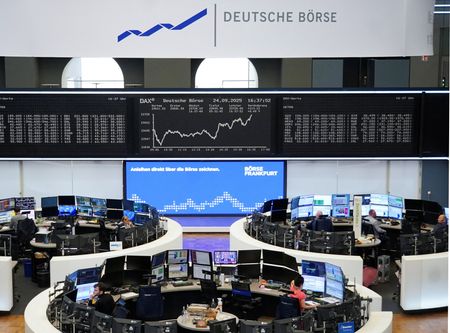BRUSSELS (Reuters) -The euro zone economy will grow more slowly this year and next because of the trade war started by the United States and uncertainty over when and how it will end, the European Commission said on Monday.
In a forecast for the 27 countries of the European Union and the 20 countries sharing the euro currency, the EU executive arm said euro zone gross domestic product will grow only 0.9% this year, rather than the 1.3% expected last November.
In 2026, euro zone growth should accelerate to 1.4%, but that would be still lower than the 1.6% the Commission had expected six months ago.
“The outlook for growth is revised significantly downward. This largely owes to a weakening global trade outlook and higher trade policy uncertainty,” the Commission said.
It said the growth outlook was based on an assumption that the U.S. would keep its tariffs at the current level of 10% on all EU goods, 25% on steel, aluminium and cars and no tariffs on pharmaceuticals and semiconductors.
“Risks to the outlook are tilted to the downside. Further fragmentation of global trade could mitigate GDP growth and reignite inflationary pressures. Climate-related disasters are also more frequent and remain a persistent source of downside risk for growth,” the Commission said.
But growth could pick up if there was a de-escalation of EU-U.S. trade tensions or faster expansion of Europe’s trade with other countries as well as through higher EU defence spending.
Euro zone unemployment will continue to fall this year and next, reaching 6.1% in 2026, and consumer inflation should decelerate to 2.1% this year and to 1.7% in 2026, from 2.4% last year, the Commission said.
But euro zone public finances will deteriorate slightly, with the aggregate budget deficit inching up to 3.2% of GDP this year from 3.1% last year and rising to 3.3% in 2026.
The aggregated euro zone public debt is likely to increase to 89.9% of GDP this year from 88.9% in 2024 and rise further to 91.% in 2026.
(Reporting by Jan Strupczewski;Editing by Sudip Kar-Gupta)










